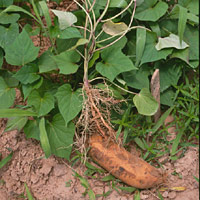Sweet Potato

Sweet potatoes are a long-season, tropical vegetable, so it's no surprise that they're grown mostly in southern states. However, it's possible
for northern gardeners to grow these tasty, highly nutritious vegetables.
About This Plant
Most sweet potato varieties require at least 4 frost-free months to grow big potatoes. Sweet potatoes thrive in hot weather. The plants are very tender, can't take frost, and refuse to grow in cool soil. Plants yield best if night temperatures average 72 degrees F. Sweet potatoes are grown from "slips," or sprouts, which are available at nurseries in southern states or by mail. If you are growing your own slips, begin sprouting them about 8 weeks before planting.
Site Selection
Select a site with full sun and well-drained soil. Prepare the garden bed by using a garden fork or tiller to loosen the soil to a depth of 12 to 15 inches, then mix in a 2- to 4-inch layer of compost.
Planting Instructions
Unless the soil is very sandy, raise the planting bed 6 to 8 inches to make a ridge 1 foot or so wide. After danger of frost is past and the weather is warm (nights above 55 degrees F), set slips 12 to 18 inches apart along ridges or in rows that are 36 to 48 inches apart. Set the slips in the soil to the depth of the first leaves with several nodes (joints) underground. Firm the soil and make a shallow depression around the plant. Water beds generously for a few days.
Care
Control weeds by hoeing or mulch the area 4 to 5 weeks after planting. Provide deep watering in hot dry periods to increase yields. If planning to store part of the crop, don't give the plants any extra water late in the season. Contact your local County Extension office for controls of common sweet potato pests such as flea beetles.
If you live in a cool climate, protect sweet potato vines from late-season frost. If vines suffer frost damage, they can transfer rot to the roots below ground.
Harvesting
Sweet potato plants will keep growing as long as the weather stays warm. The vines don't die and signal harvesttime the way white potato vines do. If you garden in a hot climate that has a long growing season, you just have to keep checking the hills and harvest the roots at the best cooking stage.
It's best to dig sweet potatoes on a dry, overcast day, or at least shade the unearthed roots from direct sun.
Let the potatoes dry on the ground for a couple of hours. Don't wash the potatoes after the harvest, either. Sort any badly cut or bruised potatoes to eat first.






 Sweet potatoes are a long-season, tropical vegetable, so it's no surprise that they're grown mostly in southern states. However, it's possible
for northern gardeners to grow these tasty, highly nutritious vegetables.
Sweet potatoes are a long-season, tropical vegetable, so it's no surprise that they're grown mostly in southern states. However, it's possible
for northern gardeners to grow these tasty, highly nutritious vegetables.